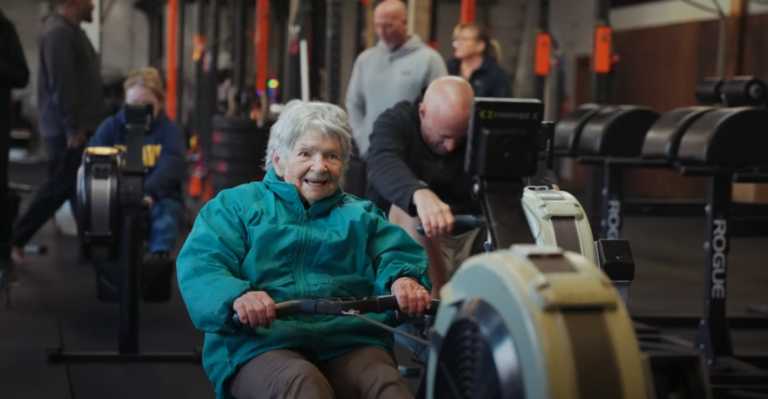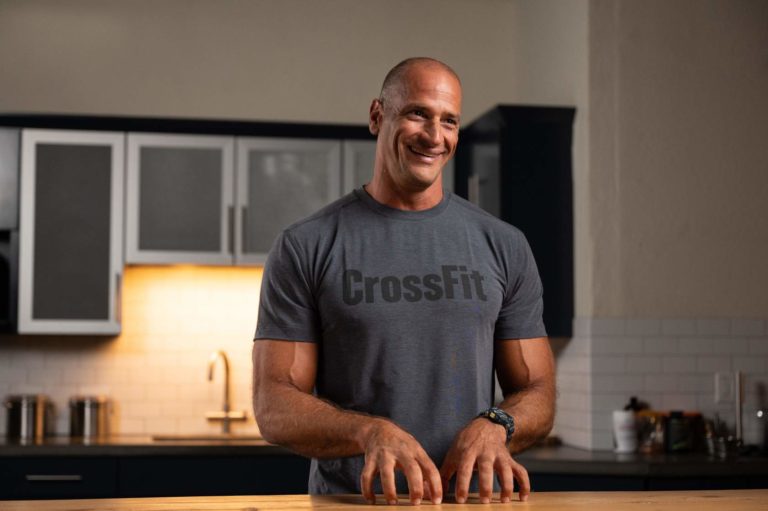Conventional thought does not paint an appealing picture of aging. Apparently, we are destined to gain fat, and lose muscle, bone density, and strength, develop painful joints with limited range of motion, suffer a sharp decline in coordination, agility, and balance, and succumb to illness. Many would have you believe our predetermined fate is an inevitable decline in functional capacity toward frailty and then to the grave.
 CrossFit has been turning this notion of aging on its head for decades. We know age does not have to be synonymous with disease or decrepitude. We have proven with thousands of older athletes that work capacity across broad time and modal domains, or fitness, can be improved at any age. Constantly varied functional movements executed at high intensity combined with a sound nutrition plan is a tried and true method for developing fitness levels in older athletes that attenuate many of the adverse effects associated with aging. CrossFit helps preserve independence by developing balance and lower body strength, reducing the risk of falls. With improved capacity, major medical risk factors such as hypertension, diabetes, coronary heart disease, stroke, and cancer are reduced, and overall life expectancy increases. When older athletes are fit enough to handle the basic tasks life demands and participate in the sports or physical hobbies they enjoy, they experience a significant improvement in their quality of life.
CrossFit has been turning this notion of aging on its head for decades. We know age does not have to be synonymous with disease or decrepitude. We have proven with thousands of older athletes that work capacity across broad time and modal domains, or fitness, can be improved at any age. Constantly varied functional movements executed at high intensity combined with a sound nutrition plan is a tried and true method for developing fitness levels in older athletes that attenuate many of the adverse effects associated with aging. CrossFit helps preserve independence by developing balance and lower body strength, reducing the risk of falls. With improved capacity, major medical risk factors such as hypertension, diabetes, coronary heart disease, stroke, and cancer are reduced, and overall life expectancy increases. When older athletes are fit enough to handle the basic tasks life demands and participate in the sports or physical hobbies they enjoy, they experience a significant improvement in their quality of life.
The Effects of Aging
Acknowledging the effects of the aging process is necessary for understanding what is possible for an older athlete. While we will all eventually experience the changes listed below as we age, the timing and extent of those changes are highly individual. Regardless of one’s aging process, we know that the best defense against the effects of aging is building a reserve of work capacity. This reserve, what we define as “fitness,” is the ability to perform physical work. The following list from CrossFit’s Coaching the Aging Athlete course outlines some of the major age-related factors older athletes must consider in their training.
The Physiological Effects of Aging
- Hormonal changes
- Reduced testosterone in men
- Reduced estrogen and progesterone in women (menopause)
- Decreased insulin sensitivity (particularly if overweight)
- Immune system changes
- Inflammation increases
- Immune function decreases
- More susceptible to illness
- Musculoskeletal changes
- Bone mineral density decreases
- Reduction in joint mobility
- Onset of osteoarthritic processes
- Decrease in muscle function
- Reduction in Type 2 muscle fibers
- Reduced stamina and cardiovascular respiratory endurance
- Cardiac, vascular, and pulmonary functions decline
- Reduction in aerobic capacity and VO2 max (O2 uptake)
- Decrease in maximal heart rate and cardiac stroke volume
- Reduced elasticity of skin and blood vessels
- Skin becomes dry and susceptible to tearing
- Reduced peripheral blood flow
- Reduced ability for skin to repair
- Capacity to recover from injury or illness decreases
- Increase in tendon stiffness
- Reduced peripheral blood flow
- Slower collagen replacement impacts wound healing
The Psychological and Neurological Effects of Aging
- Sensory-perceptual changes
- Hearing, taste, and eyesight decline
- Decreased ability to thermoregulate
- Thirst mechanism becomes less sensitive
- More susceptible to dehydration
- Neurological capacity impaired
- Reduction in coordination, accuracy, agility, and balance
- Reduction in fine motor skills and proprioception
- Increased fall risk
- Loss of nerve tissue and peripheral nerve function
- Neurobiological changes
- Reduced neuroplasticity
- Reduced ability to learn neurological skills
- Cognitive changes
- Increased problem-solving skills with greater life experience
- More prone to overthinking
- Personality changes
- Seeking a more purposeful life
- Changes in what is meaningful
- Social changes
- Changes to the family unit
- Career changes and transition to retirement
The degree to which these changes result in functional decline is more a result of lifestyle factors than age. Your choices, such as remaining active, ensuring good nutrition, and avoiding known risk factors (like smoking and alcohol), can delay and minimize the effects of aging. This puts the power in your hands to shape your health and well-being.
For an older athlete looking to implement a fitness program, the first step is to examine their current level of fitness, training background, and injury history. This assessment helps determine an appropriate starting point. The older, more deconditioned, or more injured the athlete, the more conservative the approach to training must be initially. At the outset of training, finding versions of functional movements the older athlete can complete easily is essential. This might look like push-ups done standing up and against a wall, air squats to a high box, or presses with a PVC pipe. The key is that the athlete can perform the exercises for the required reps relatively easily with proper form. From here, the athlete progresses slowly. The emphasis is on developing excellent mechanics and consistency in various functional movements. Once a suitable level of mastery has been achieved in a collection of movements, intensity can be applied judiciously. This includes small increases in load and intelligently pushing the pace in workouts, all while maintaining excellent technique. It is critical for the older athlete and their trainer to understand that a conservative approach to volume, load, and intensity is the best approach.
Due to the physiological, neurological, and psychological changes listed above, older athletes are more susceptible to injury and take longer to adapt to training factors such as load and volume changes. Any increases in intensity, reps, sets, and loads should be small and manageable. If the athlete or trainer wonders if a certain weight, movement or workload should be attempted, the answer is likely no. The athlete’s mentality should be to progress slowly toward challenges currently out of their reach at their present capacity. This is the essence of the “philosophy of starting where they are.” It emphasizes the importance of individualized training, where the focus is on the athlete’s current abilities and gradual progression, rather than comparing to others or setting unrealistic goals. By maintaining a relentless focus on mastering movement technique and conservatively increasing intensity over a long time horizon, older athletes can continue to improve their fitness consistently over the long term, enjoying dramatic results that significantly improve their health and quality of life well into their later years.
Resource
Coaching the Aging Athlete is a in-depth course outlining the special considerations trainers must take into account when training older athletes.
About the Author
 Stephane Rochet is a Senior Content Writer for CrossFit. He has worked as a Flowmaster on the CrossFit Seminar Staff and has over 15 years of experience as a collegiate/tactical strength and conditioning coach. He is a Certified CrossFit Trainer (CF-L3) and enjoys training athletes in his garage gym.
Stephane Rochet is a Senior Content Writer for CrossFit. He has worked as a Flowmaster on the CrossFit Seminar Staff and has over 15 years of experience as a collegiate/tactical strength and conditioning coach. He is a Certified CrossFit Trainer (CF-L3) and enjoys training athletes in his garage gym.
Comments on Aging Gracefully Redefined
=)
Aging Gracefully Redefined
1